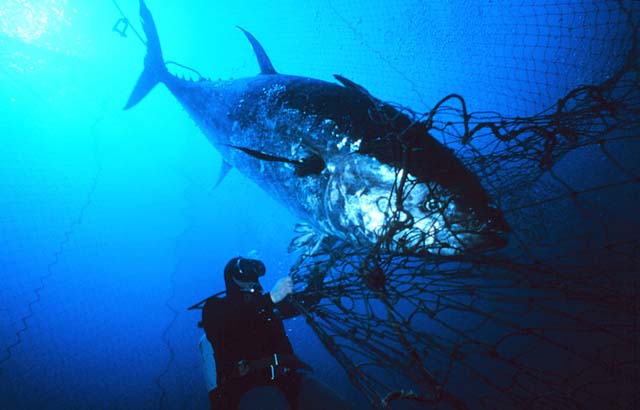Seafood industry severely threatened by climate change, warns report

[dropcap]A[/dropcap]ll but the dullest bulbs know that climate change poses a huge threat to the oceans, including rising sea levels and coral reef bleaching, but you may be wondering how that trickles down to your dinner plate. The overarching theme of the recent 1,552-page Intergovernmental Panel on Climate Change (IPCC) Fifth Assessment Report (AR5) found that climate change is undeniable, mostly caused by human activities, and is occurring globally. AR5 honed in on the effects of climate change on seafood, and found that climate change won’t fare well for many consumers or fishermen alike.

Humans can kill-off the oceans top predators many ways. Here a 600-pound bluefin tuna gets entangled to death in a fish trap. Credit: NOAA’s Elizabeth Brown, research scientist at Blue Ocean Institute.
Fortunately, a new report published by several organizations—including the Sustainable Fisheries Partnership, the University of Cambridge Institute for Sustainability Leadership and Judge Business School, and the European Climate Foundation—translated AR5’s fisheries and aquaculture information into a shortened report.
Overall, the condensed report found that climate change is affecting the physical and chemical properties of the ocean, thereby threatening coral reefs and fisheries. This trickles down to affect a seafood supply that a growing 400 million people depend on, with a total loss of landings estimated to range from 17 to 41 billion U.S. dollars by 2050.
“This report is a wake-up call for the seafood industry to recognize the scale of the threat to ocean resources from climate change and acidification,” said Blake Lee-Harwood, the Communications and Strategy Director at the Sustainable Fisheries Partnership. “We need to see urgent action in trying to mitigate the likely impacts while adapting wherever that’s practically possible.”
Take a look below at the five key effects the report outlined of climate change on seafood, and learn how Oceana is working to address all of these issues.
1. Climate change and acidification are severely impacting the oceans, which means that fisheries are affected too. Fish and shellfish will be impacted by temperature changes and oxygen levels, which will shift their migration, spawning, and feeding patterns. In some cases, these changes could benefit fisheries by creating longer growing seasons and range expansions, but the effects will be negative more often than not.
Oceana works to stop climate change through legislative work that advocates for reduced greenhouse gas emissions and controlled unregulated sources of greenhouse gases like shipping emissions, while also fighting against offshore oil and gas drilling. Click here to learn more . . .
2. Globally, the impacts of climate change and acidification will be negative, including stock displacement and shellfish mortality from acidic water. Climate change has already started to affect distribution and abundance of marine organisms, and primary production decreased by 10 percent from 1998 to 2010. Scientists estimate that more fish will migrate to the high-latitudes, including top predator species, while the tropics will experience local extinctions.
Oceana promotes framework that encourages cleaner energy sources like offshore wind and solar, which will help stabilize atmospheric carbon dioxide and keep acidification at bay.
3. Other threats to the oceans like overfishing, habitat loss, and pollution only exacerbate these issues, and lead to dead zones and harmful algal blooms. Smaller fish are predicted for the future as dead zones limit their growth.
One of Oceana’s biggest campaigns is to promote responsible fishing, which can help mitigate the effects of climate change by avoiding over-exploitation of fish populations. This includes working to reduce bycatch, setting responsible fishing quotas, limiting bottom trawling, and more. You can learn more here . . .
4. Climate change is really taking a toll on coral reefs—to the extent that some coastal fisheries are at risk from collapse. More than half of the world’s reefs are at medium or high risk of degradation, which support vast fisheries and biodiversity.
Oceana works to protect essential fish habitat—like coral reefs—by campaigning to limit bottom trawling, setting conservative catch limits, and advocating for new marine protected areas. Click here to learn more . . .
5. But, some fishermen may be able to adapt to these changes through measures like reducing pollution, changing gear or target species, and introducing dynamic management policies.
Oceana continuously works to create sustainable fishery management plans. This includes adjusting gear type, setting catch quotas, and other initiatives. More information can be found here . . .
The fight to protect the oceans and fisheries from climate change is not over, and mitigation is possible. For example, the report notes that opportunities exist for the seafood industry to reduce dependency on greenhouse gas emissions, while fishermen can protect their catches now by strengthening coastal zone management and creating new habitat like artificial reefs. These practices will ensure that healthy and vibrant oceans—including our seafood supply—can exist in future generations.
[information]
[/information]






